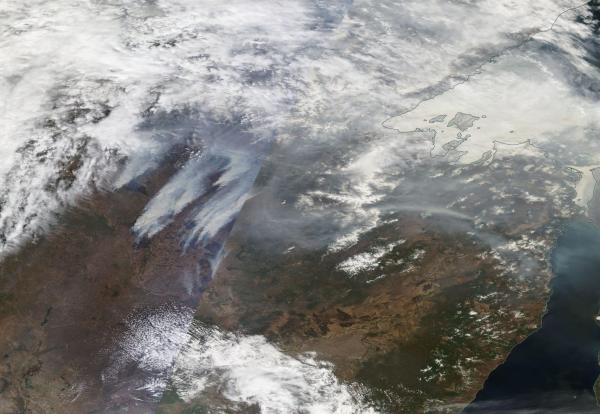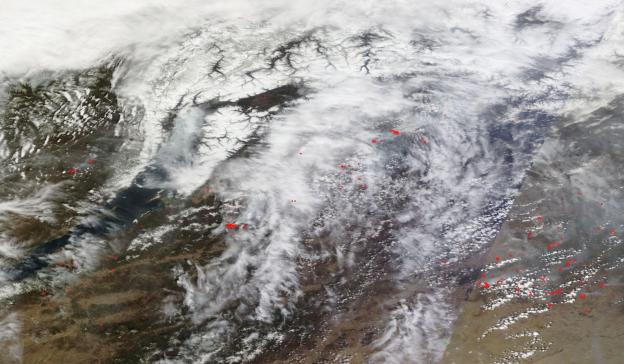Massive Wildfires Erupt in Northeast China as Lake Baikal Blazes Ignite
10
May, 2016
As
human fossil fuel emissions force the world to warm, moisture
and precipitation levels are changing. Wet
areas become wetter. Dry areas become drier.
Spring and Summer temperatures increase. And earlier
spring snow-melt causes
soils to remain drier for longer periods, increasing incidents of
drought while lengthening the wildfire
season. These
hot, dry conditions also increase the likelihood that, once wildfires
are started by lightning strikes or human error, they will
become more
intense, larger and long-burning (paraphrase
of this Union
of Concerned Scientists Report).
******
An
extreme heatwave and drought in East Asia is now sparking
extraordinarily large wildfires in mostly unsettled regions of
Northeast China near the Russian border. The massive fires are
plainly visible in the LANCE-MODIS satellite shot and include at
least four contiguous fire zones. The fires each show very large burn
scars with fire-fronts ranging from 10 to 40 miles across. In
essence, what this satellite shot is showing are 3-4 Rhode Island
size infernos.
(Enormous
wildfires burning in Northeast China on May 10th. For reference,
bottom edge of frame is 600 miles. Image source: LANCE
MODIS.)
A
very large smoke plume cast off from these blazes is now visible in
the MODIS satellite shot. It stretches away from the massive burn
scars and on out into the Sea of Japan nearly 1,000 miles away. By
comparison, the Northeastern China fires together now dwarf the
recent massive blaze that burned 2,400 structures in the Canadian
town of Fort McMurray over the past week. Yet another instance of
extraordinarily large fires burning in a world forced to warm by
human fossil fuel emissions.
Thankfully,
the Northeast China fires aren’t currently raging near any large
settlements. So it is less likely that loss of life or property has
occurred as a result. International news media has no reports on the
blazes, so little information is now available other than what can be
discerned by NASA satellite map analysis.
In
context, these fires ignited along a ridge zone that has featured
extremely warm and dry temperatures. Rising off a heatwave that began
in Southeast Asia, these
warm airs are now expanding northward toward the Arctic and will,
over the current week, contribute to an amazingly potent heatwave
building over the rapidly thawing regions of our world.
Ridge development in this zone has been quite persistent and we can
expect continued large fires creeping north toward the Arctic.
(Wildfires
— indicated by red spots in the above map — are lighting off
around the discontinuous permafrost zone near Lake Baikal. During
recent years, this region of Russia has suffered from the kind of
extreme drought and warming associated with human-caused climate
change. Image source: LANCE
MODIS.)
This
extremely hot and dry zone has also lit off numerous fires in the
Lake Baikal region. Representing the furthest southern extent of the
Northeast Asian permafrost zone, heat and thaw in the region due to
global warming have resulted in increasing fire hazards. As with
Northwest Canada, an unholy relationship exists between fires and
thawing permafrost. The permafrost as it thaws and dries provides an
understory fuel that aids in fire persistence and intensity —
sometimes resulting in hotspots that smolder throughout the winter.
And the fires can activate more and more of the permafrost layer
below — pumping out additional carbon which can worsen the warming
trend which ignited the fires in the first place.
For
2016, warm, dry ridge zones have tended to dominate both Western
North America and Eastern Asia. And in a world that since the start
of 2016 has been nearly 1.5 C above 1880s averages, we have seen a
very intense early start to fire season featuring numerous very large
fires in these zones. As May progresses into June, risks for even
more intense fires increase even as the fire zone advances with the
warm airs heading north toward the Arctic.
Links:
Hat
Tip to Andy in San Diego





No comments:
Post a Comment
Note: only a member of this blog may post a comment.